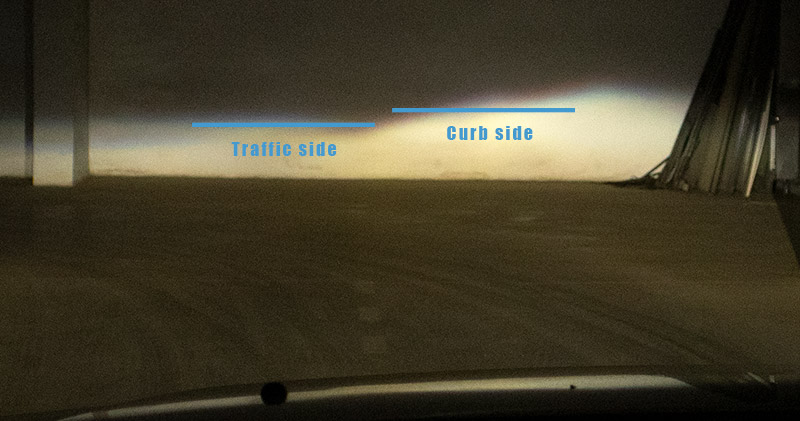
| Headlight | Wall target height | Angle |
|---|---|---|
| Left | - | - |
| Right | - | - |

| Headlight | Wall target height | Angle |
|---|---|---|
| Left | - | - |
| Right | - | - |
In order to use this calculator, you need to park you car on a level surface against a wall. Then measure 2 things:
Then enter the values in the calculator. You also need to know how far you want the light throw distance to be - this is how far ahead of the car you want to light up the road. We have limited the calculator to safe values, otherwise you risk blinding oncoming traffic. You can safely leave this value at default.
Finally, the calculator will output the "wall target height". Adjust your headlights so the beam projected on the wall is as high off the ground as these values.
Ideally, this is the effect you want to achieve:

Correctly aimed headlights improve your nighttime visibility while preventing glare for oncoming drivers. If your headlights point too high you risk blinding other road users and also your light is more dispersed and causes poorer visibility for you. If they point too low you can’t see hazards in time. Although most vehicles come pre-adjusted from the factory, worn suspension components, heavy loads or bulb replacements can alter the aim over time. Also, some modern vehicles come with the beam adjusted far too low.
In order to prevent blinding oncoming traffic, the headlight that is to the side of traffic is always adjusted a bit lower.
Vehicles driven on the right side of the road (left-hand drive) have the left headlight pointing slightly lower to prevent blinding oncoming traffic. Conversely, vehicles driven on the left side (right-hand drive) lower the right beam. Our tool automatically applies a shorter throw distance to the traffic-side lamp - five metres in metric or fifteen feet in imperial units.
Most modern headlight assemblies feature two adjustment screws or bolts: one for vertical aim and one for horizontal aim. They are typically accessible from the top of the headlight housing under the bonnet or behind removable covers. Consult your owner’s manual for the exact location and recommended procedure. Always make small adjustments and re-check your beam pattern after each turn.
By all means, we encourage you to use a professional's services if you want to be 100% sure that your headlights are aligned properly. This calculator will not help with horizontal alignment, but it will still provide the correct method for you in case you want to do vertical alignment yourself. And, most importantly, you will have a good light cone without blinding oncoming traffic.
If your car has modern matrix headlights, DO NOT adjust them by using this calculator. Matrix headlights are adjusted using complex algorithms connected to your car's forward camera. If they are misaligned, they may not function properly.